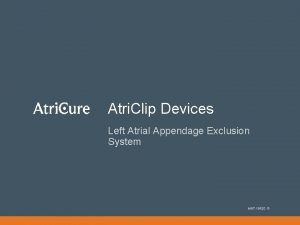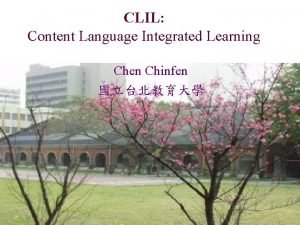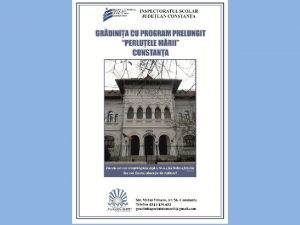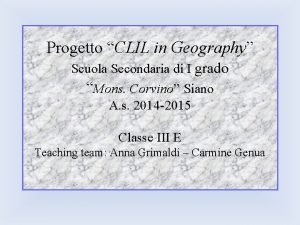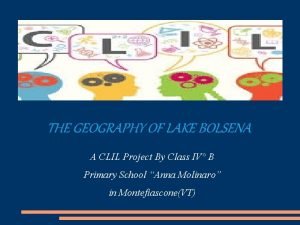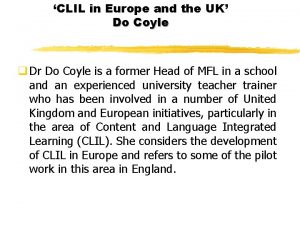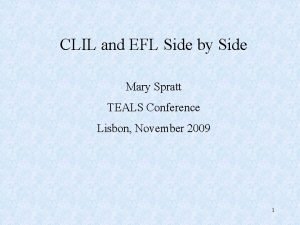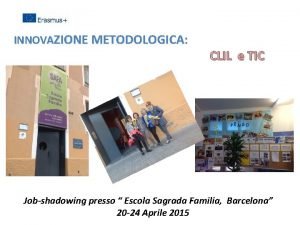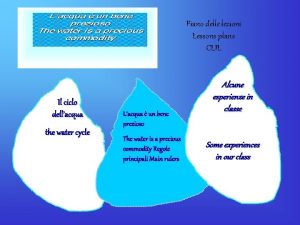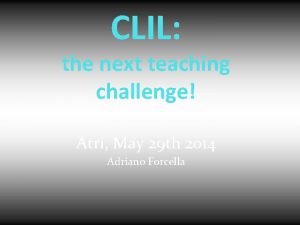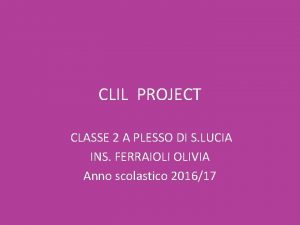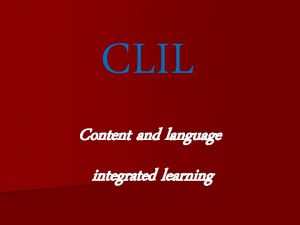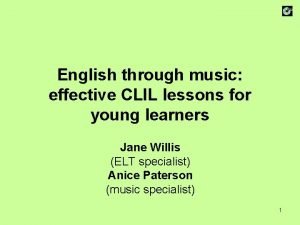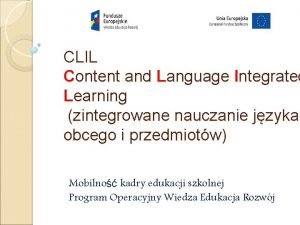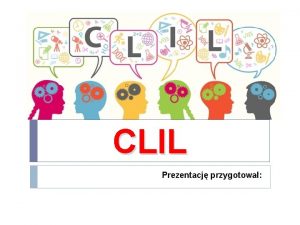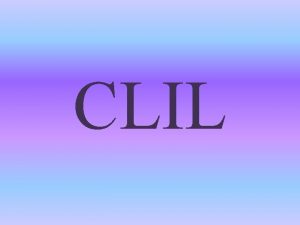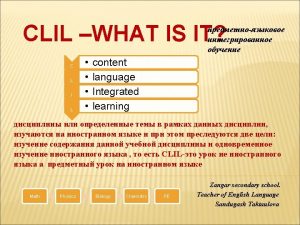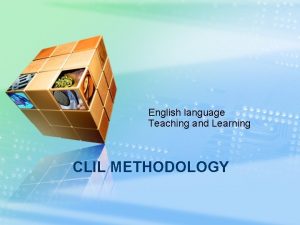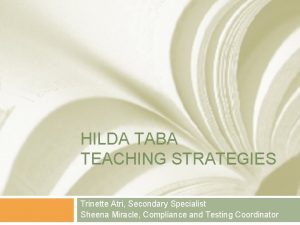CLIL the next teaching challenge Atri May 29

























- Slides: 25

CLIL: the next teaching challenge! Atri, May 29 th 2014 Adriano Forcella

What exactly is CLIL? Content and Language Integrated Learning It means learning new subject matter through the medium of a non-native language Content first! It is important to notice that “content” is the first word in CLIL (curricular content leads language learning)

Why is CLIL a challenge? Introducing CLIL into Italian schools poses a number of problems, such as: CLIL is complex There is no single model for CLIL – the context is to be taken into account Who is to teach CLIL? Subject teachers, of course! They need to be supported! Curricular teachers in CLIL programmes have to know the specific academic language that learners need (They often lack the language fluency)

Why is CLIL an opportunity? It is authentic, naturalistic learning, language bath and real communication Accelerates learning Primacy of meaning over form Fosters communicative competence Nurtures a feel good (fun!) and can do attitude Fires the brain up, fires the neurons, rejuvenates teaching Serves as a platform for students’ interest in other languages and cultures Gives feelings of professional satisfaction and cooperation to teachers

Why CLIL? Which goals? The basic principle is. . . use as you learn and learn as you use not learn now and (maybe) use later Develop intercultural communication skills Prepare for internationalisation Provide opportunities to study content through different perspectives Access subject-specific target language


Content Communica tion These four principles are essential to the CLIL approach. They should be used as the framework for creating and delivering successful lessons Cognition Culture


CONTENT Content refers to the subjects or theme of the lesson or course. Examples of different content areas include physics, science, maths, history, geography, cookery. When planning the content of our lessons it is essential to think of the knowledge, skills, and understanding we want our students to learn (but not only knowledge, competences e. g. )

Communication

COMMUNICATION Communication refers to students using the target language to communicate their thoughts, opinions, attitudes, and discoveries related to the lesson content. Both speaking and learninginteraction are emphasized Students engage in meaningful with each other. Group worktois use very the common. as students “learn language and use language to learn”. (Coyle) The aim is for students to produce authentic language, not to memorize grammar rules and parrot the teacher.

Cognition

COGNITION Cognition refers to the critical thinking skills that students use to engage with and understand course content, to solve problems, and to reflect on their learning.

Culture

CULTURE Culture (also known as community and citizenship) refers to the learning community of a class and school and more broadly to local and global cultures. Students are encouraged to understand themselves as citizens of the world understand both their own culture and other cultures. The ultimate goal is to promote the international awareness and understanding.

Conceptual map for understanding CLIL: holistic, symbiotic view (developed by Do Coyle)

Language Triptych

Three interrelated types of language L of learning – content obligatory language related to the subject theme or topic L for learning – language needed to operate in foreign language environment (for pair/ group work, asking questions, debating, etc. ) L through learning- new language that cannot be planned. This emerging language needs to be captured, recycled and developed so that it becomes a part of a learner’s repertoire

Considerations when planning a CLIL lesson Activating prior knowledge – it is helpful to start the lesson by finding out what the learners already know about the topic. Input and output – teachers need to plan the input and also the learners output. Wait time – the time teachers wait between asking question and learners answering them. Cognitive challenge – learners usually need considerable support to develop their thinking skills in a non-native language.

Considerations when planning a CLIL lesson Collaborative tasks – tasks involving learners in meaningful pair or group work activities. Material and resources Cross curricular links Assessment

What difficulties do CLIL teachers have to face? Subject teachers need to be confident about their language level Be able to present and explain concept in their subject area clearly and accurately Check pronunciation of subject-specific vocabulary Be able to use appropriate classroom language to present new concepts, to question, to guide, to suggest …

What difficulties do CLIL learners have to face? Most learners need considerable support in the first two years of CLIL courses Learners may need support in input and task

How can CLIL teachers overcome the difficulties they face? What can subject teachers do? Use an online dictionary with audio function to hear the pronunciation of specific vocabulary; Use a grammar reference book in order to practice the language needed; Make sure the learners know the language needed to talk about their subject area; If possible, they can plan curricular topics with the language teachers so as he can benefit from the colleagues’ area of expertise.

How can CLIL learners overcome the difficulties they face? What helps learners learn? Large use of vocabulary and diagrams on the worksheets Use of labs and workshops with the exploitation of the related materials Use of pictures Use of easy words for the explanations Building of a scientific glossary Add a list of vocabulary and illustrations Maybe put the most difficult words with translation Appropriate tasks to motivate the learners, involve their interaction and develop their thinking skills.

BREAK A LEG, FOLK! Thank you for your kind attention!
 X.next = x.next.next
X.next = x.next.next Nato a milano 1785
Nato a milano 1785 Atri clip
Atri clip Atrial clip procedure
Atrial clip procedure Whitchester house
Whitchester house Clil meaning
Clil meaning Progetto clil
Progetto clil Componentele metodei clil
Componentele metodei clil Clil geography
Clil geography Clil geography primary school
Clil geography primary school Clil meaning
Clil meaning Water water everywhere project
Water water everywhere project Do coyle
Do coyle Clil meaning
Clil meaning Language
Language Metodologia clil
Metodologia clil Tic e clil
Tic e clil Clil ciclo dell'acqua
Clil ciclo dell'acqua Clil meaning
Clil meaning Clil
Clil Clil showers
Clil showers Xalqaro clil metodi
Xalqaro clil metodi Clil music lesson plan
Clil music lesson plan Tctfl
Tctfl Hard clil
Hard clil Clil przykłady
Clil przykłady



